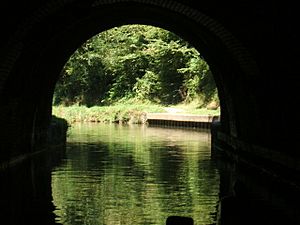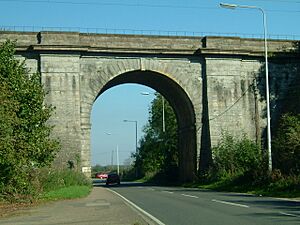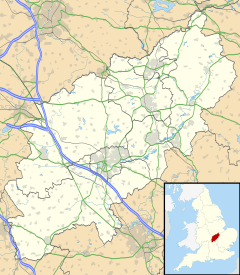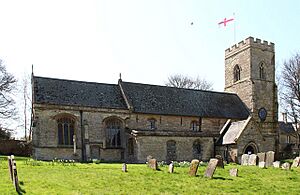Blisworth facts for kids
Quick facts for kids Blisworth |
|
|---|---|
 Blisworth Tunnel on the Grand Union Canal - north entrance from inside the tunnel |
|
| Population | 1,786 (2001 Census) 2,867 (2011 Census) |
| OS grid reference | SP727534 |
| • London | 66 mi (106 km) |
| Civil parish |
|
| District |
|
| Shire county | |
| Region | |
| Country | England |
| Sovereign state | United Kingdom |
| Post town | NORTHAMPTON |
| Postcode district | NN7 |
| Dialling code | 01604 |
| Police | Northamptonshire |
| Fire | Northamptonshire |
| Ambulance | East Midlands |
| EU Parliament | East Midlands |
| UK Parliament |
|
Blisworth is a village in West Northamptonshire, England. It is a small community with a rich history. The village is known for its connection to the Grand Union Canal and the Blisworth Tunnel. This tunnel is one of the longest on the English canal system.
The West Coast Main Line railway also runs next to the village. This busy railway connects London to places like Manchester and Scotland. The name Blisworth means 'Blith's enclosure', which tells us it was once a fenced-off area belonging to someone named Blith.
Contents
Where is Blisworth Located?
Blisworth is about 5 miles (8 km) south of Northampton. It is also 4 miles (6 km) north of Towcester. The large city of Milton Keynes is about 10 miles (16 km) south. The M1 motorway, a major highway, is only about 2 miles (3 km) away.
People and Local Government
In 2001, about 1,786 people lived in Blisworth. By 2011, this number grew to 2,867. The village has homes and a few small businesses.
How Blisworth is Governed
Today, West Northamptonshire council manages the local area. Before 2021, Blisworth was part of the South Northamptonshire Council. The village also has its own local Parish Council. This council has eleven elected members who help make decisions for the community.
For national elections, Blisworth is part of the South Northamptonshire area.
Village Life and Facilities
Blisworth has many things that make it a great place to live.
Schools
The village has its own primary school, called Blisworth Community Primary School. Around 200 children attend this school. Some children come from nearby areas too. For older students, the local secondary school is Elizabeth Woodville School. It has campuses in Roade and Deanshanger.
Shops and Services
Blisworth has a small supermarket. This shop also acts as a post office and newsagent. There is a modern doctor's surgery on Stoke Road. It serves Blisworth and several surrounding villages.
Places to Eat and Stay
The village has a pub called The Royal Oak. There is also a hotel, The Walnut Tree Inn. This building used to be the original hotel for the old Blisworth railway station.
Churches
Blisworth has two churches. One is a Church of England church, and the other is a Baptist Chapel. The Baptist Chapel was made larger in 1871.
Sports and Events
The village has its own football club, Blisworth F.C..
Every August, Blisworth holds an annual Canal Festival. This festival celebrates the important role the canal has played in the village's history. The Blisworth Canal Partnership organizes this event. They work to promote and improve the canal area.
Travel and Transport
Canal Travel
The Grand Union Canal runs through Blisworth. The famous Blisworth Tunnel is a key part of this canal. It runs south to the nearby village of Stoke Bruerne. A bridge in the village carries the main road over the canal.
Roads
A major road, the A43, used to go right through Blisworth. However, a by-pass was built and opened in 1991. This new road goes around the west side of the village. It connects to the M1 at a new junction, 15A. The by-pass follows the path of an old railway line that is no longer used.
Railways

The London and Birmingham Railway opened a station in Blisworth in 1839. This was because the railway line bypassed Northampton. In 1842, a new "first class" station was built. This meant all trains had to stop there.
Later, branch lines were added from Blisworth to Northampton and Peterborough, and also to Banbury. However, Blisworth station closed in 1960. Both branch lines are also gone now.
The main railway line is still very active. It is part of the West Coast Main Line. Fast trains, traveling at 125 miles per hour, use this line. They connect London Euston to Glasgow. A special loop line, called the Northampton Loop, leaves the main line near Blisworth. This loop takes trains into Northampton.
Important Buildings
Blisworth has many interesting old buildings. Many are traditional stone cottages, some with thatched roofs. These buildings line the Towcester and Stoke Roads. Here are a few notable ones:
- Walnut Tree Inn: This building used to be the Blisworth Station Hotel. It is across from where the old railway station once stood.
- Robert Stephenson's railway bridge: Also known as the Blisworth Arch, this bridge was built in 1837-1838.
- Village Hall: This building on Stoke Road was originally the village school. It was rebuilt in 1799 after a fire.
- Blisworth House: Located on Church Lane, this house was rebuilt in 1702.
- Blisworth Stone Works: Found on Stoke Road, this building dates back to around 1821.
- The Old Toll House: Near the Blisworth Arm of the canal, built around 1800.
- Blisworth Mill: On Gayton Road, this old steam-powered flour mill was built in 1879. It has since been turned into apartments.
- Grafton Villas: These homes on Northampton Road, near the railway bridge, were built in 1820.
- St John the Baptist Church: This Anglican church was built between the 13th and 15th centuries. It was restored in 1856. It is a Grade II* listed building, meaning it is very important historically.
- The Rectory: West of the church, built in 1841.
- Stoneacres: On Stoke Road, this 17th-century building is a great example of using local stone.
Quarrying History
For many years, Blisworth was a place where people dug for iron ore and limestone.
In 1821, a limestone quarry started. It was connected to the canal by a horse-drawn tramway. This tramway carried stone to boats on the canal. This quarry closed around 1912.
Later, iron ore quarrying began. The ore was sent to different places, including Staffordshire and South Wales. At first, horses and carts carried the ore. Then, tramways were built to move the ore to the canal or the railway station. Steam cranes were even used to load the ore onto boats and trains. These iron ore quarries closed in 1921. You can still see some signs of them today, like lower field levels.
More recently, another limestone quarry opened. This was to get stone for building the M1 motorway. This quarry is now a nature reserve.
Images for kids
See also
 In Spanish: Blisworth para niños
In Spanish: Blisworth para niños






